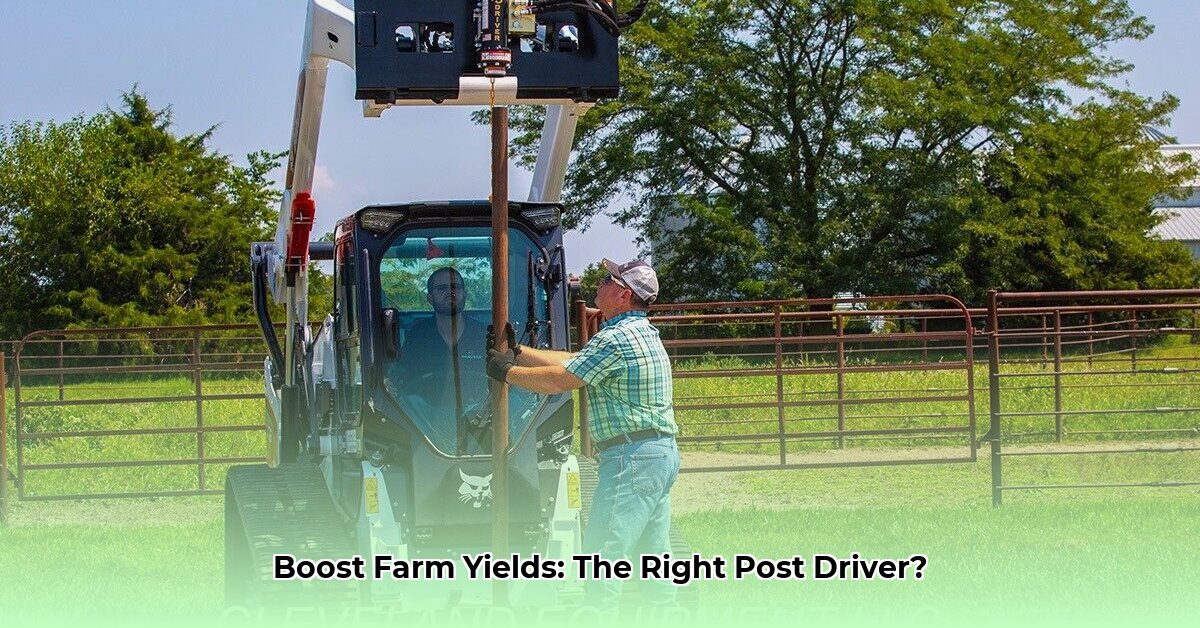
Efficient fencing is crucial for sustainable agriculture, impacting grazing management, crop protection, animal safety, and even soil health. But building those fences starts with selecting the right post driver. This guide helps you choose the perfect post driver from Tractor Supply, considering your farm's unique needs and prioritizing both efficiency and sustainability. For smaller farms, consider a subcompact tractor solution.
Matching Your Post Driver to Your Farm
Before exploring specific models, assess your farm's individual requirements. This ensures you invest in a tool perfectly suited to the job.
Farm Size and Scale: A small hobby farm might benefit from a manual post driver, offering low cost and minimal environmental impact. However, large-scale operations will appreciate the speed and efficiency of a powered model. Isn't time a valuable resource on a large farm?
Terrain and Soil Conditions: Rocky or hard-packed soil demands a powerful driver for efficient post setting. Conversely, gentler terrain might tolerate a lighter-duty model, minimizing soil disturbance. Consider the long-term effects on your land.
Budget and Cost-Benefit Analysis: Manual post drivers have lower upfront costs but demand more labor. Powered options, while initially more expensive, offer considerable time savings, a critical factor for large-scale operations. Carefully weigh initial investment against long-term labor costs. Remember to factor in fuel or electricity costs for powered drivers and maintenance for all types.
Fencing Materials: The type of fencing (wood, metal, vinyl) influences post driver selection. Heavier materials typically demand more powerful drivers. Consider the strength and durability of different fencing materials.
Exploring Your Options: Types of Post Drivers
Let's examine the available post driver types, comparing their strengths and weaknesses for sustainable farming practices.
Manual Post Drivers
- Pros: Affordable, low-maintenance, environmentally friendly (zero emissions). Ideal for small projects.
- Cons: Labor-intensive, slow, unsuitable for large-scale projects or challenging terrain. Will your physical stamina match the demands of the project?
Powered Post Drivers
These offer significant time savings compared to manual options, particularly for larger projects. Two main types exist:
Gasoline-Powered Post Drivers
- Pros: Powerful, versatile, ideal for difficult terrains and large projects.
- Cons: Higher initial cost, ongoing fuel expenses, maintenance requirements, and environmental impact due to emissions. Consider the overall environmental impact alongside the immediate benefits.
Electric Post Drivers
- Pros: Quieter operation, reduced emissions compared to gasoline models, lower maintenance.
- Cons: Require a power source, may have less power than gasoline models for challenging tasks. Does your farm have reliable access to electricity?
Choosing Your Post Driver: A Practical Guide
Selecting the right post driver involves a systematic approach:
Assess your farm's specific needs: Consider farm size, terrain, budget, and fencing material.
Research and compare models: Explore Tractor Supply's offerings and compare specifications (power, weight, features) and user reviews.
Analyze long-term costs: Factor in fuel/electricity expenses, maintenance, and the value of labor saved.
Read independent reviews: Consult online reviews from fellow farmers for realistic performance feedback. Independent reviews provide valuable, unbiased insights.
Make your informed decision: Select the post driver that best aligns with your needs and budget.
Safe Post Driving Practices
Safety is paramount. Always:
- Follow the manufacturer's instructions meticulously.
- Wear appropriate safety gear (gloves, safety glasses, sturdy boots).
- Ensure a clear work area before operation.
- Never force the post driver; this can lead to equipment damage or injury.
Sustainability Considerations
Your post driver choice has broader environmental implications:
- Fuel Efficiency: Electric or battery-powered models minimize your carbon footprint compared to gasoline options.
- Fencing Material Choice: Select durable materials to reduce waste and the need for frequent replacements.
- Reduced Maintenance: Proper maintenance prolongs equipment life and minimizes waste.
Prioritizing sustainability benefits your farm's long-term health and reduces your environmental impact.
Best Post Driver for Sustainable Rotational Grazing
Efficient fencing is fundamental to rotational grazing, maximizing forage and minimizing soil degradation. Choose your post driver wisely.
Key Factors for Rotational Grazing
- Farm size and budget: Evaluate the scale of your operation and your budget's limitations.
- Terrain: Choose a driver suitable for your soil conditions.
- Fencing materials: Select a driver compatible with your chosen fencing materials.
- Environmental impact: Prioritize fuel efficiency and environmentally friendly choices.
Step-by-Step Post Driving for Rotational Grazing
- Preparation: Clear the area around the post hole to ensure a solid base.
- Positioning: Align the post driver correctly for efficient and accurate post setting.
- Driving the Post: Engage the driver according to manufacturer instructions.
- Stability Check: Verify post placement and depth for optimum fence stability.
- Safety Precautions: Always prioritize safety by wearing appropriate safety gear and maintaining a safe work environment.
Minimizing Environmental Impact in Rotational Grazing
Choose durable fencing materials and prioritize fuel-efficient post drivers (electric or battery-powered). Proper fence maintenance and responsible material sourcing minimizes the impact on the environment. Sustainable farming practices extend to every aspect of your operation, including the selection of your post driver.